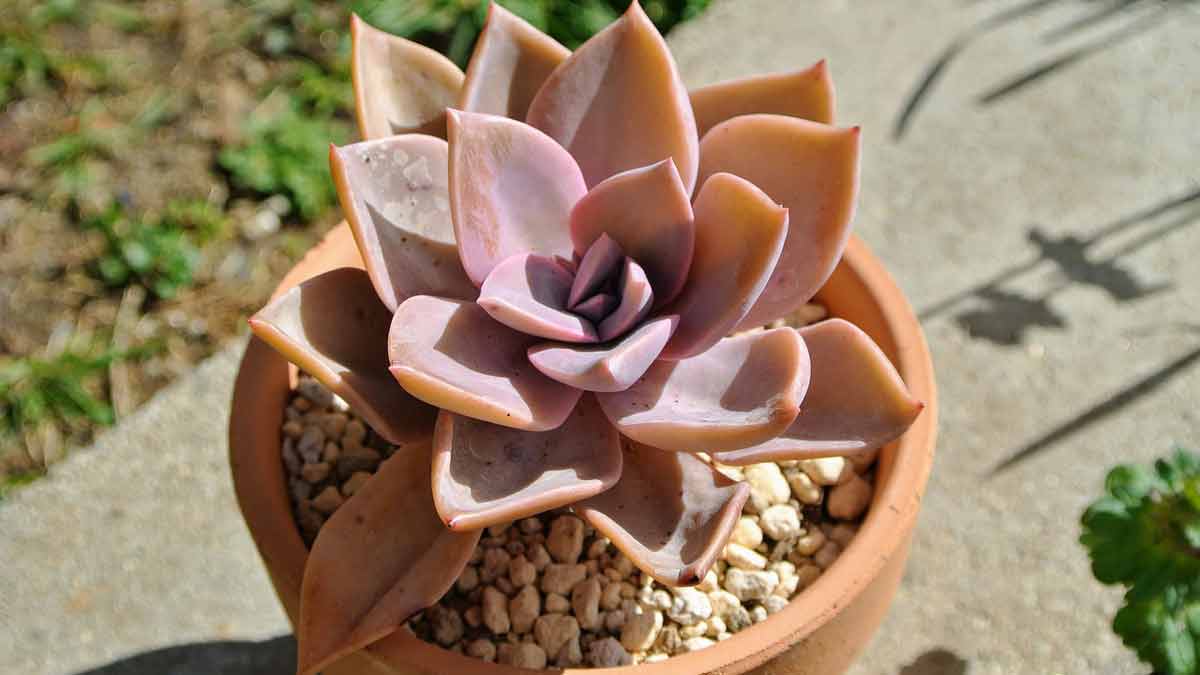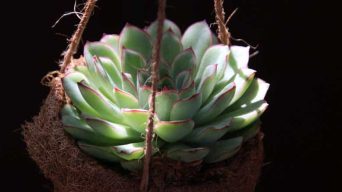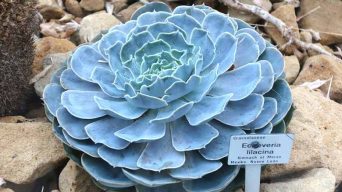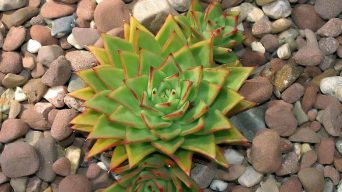Key Takeaways
- Echeveria plants require 4 – 6 hours of bright, indirect sunlight each day for optimal growth and development.
- Too much direct sunlight can harm Echeverias by scorching their leaves, while too little may cause stretching and stunted growth, so monitor their exposure carefully.
- Location, season, and climate significantly determine the right amount of sunlight for your Echeveria plant’s needs.
- Providing shade during peak sun hours is crucial to prevent excessive exposure that may lead to leaf scorching or dehydration.
Echeveria plants are prized for their distinctive rosettes, jewel-tone leaves, and low-maintenance requirements.
As a plant owner, it is natural to wonder if these popular succulents need direct sunlight or how much light they truly require.
Striking the perfect balance of sun exposure can be crucial in keeping your Echeveria healthy and vibrant.
In this blog post, we will delve into the light requirements for Echeverias and discuss factors that affect sunlight exposure, along with practical tips to ensure your beloved plants receive just the right amount of sunshine they need.
Understanding The Light Requirements For Echeveria Plants
Different species of Echeveria plants require different amounts of sunlight for optimal growth and development.
It’s important to provide the appropriate light conditions for each species.
Types Of Light Requirements
Like many other succulents, Echeveria plants have specific light requirements to ensure optimal growth and development.
Understanding these needs is essential for any plant owner seeking a thriving Echeveria collection.
Bright direct sunlight refers to the intense rays received from the sun during peak hours without any obstruction.
Although Echeverias require a substantial amount of light to thrive (at least 4-5 hours daily), too much direct sunlight can cause harm by scorching their leaves.
On the other hand, bright indirect sunlight means that while plenty of natural ambient lighting is available in a space, it isn’t directly hitting the plant at full strength.
Think about an area near a window where soft light filters through sheer curtains or bounces off nearby surfaces.
Ideally, most Echeveria varieties prefer this type of exposure, as they need 4-6 hours of illumination daily for healthy growth.
How Much Sunlight Do Echeveria Plants Need?
Echeveria plants thrive when they receive approximately 4-6 hours of bright, indirect sunlight each day.
This succulent species is known for its ability to adapt well to various lighting conditions but prefers a balance between direct sun and shade to ensure healthy growth.
For instance, exposing your Echeveria plant to morning sunlight is beneficial as it provides the right amount of light without the harsh intensity that the afternoon sun can bring.
Gradually acclimating these plants to full sun exposure is vital in preventing any drastic changes which may negatively impact their health.
The Effects Of Too Much Sunlight
Excessive sunlight can harm Echeveria plants, causing sunburned leaves that may manifest as brown or white patches.
The scorched areas are unsightly and compromise the plant’s health by reducing its ability to photosynthesize effectively.
One notable example is a sudden change in lighting conditions when you move an indoor Echeveria outdoors without proper acclimatization.
This abrupt transition could expose the succulent to intense direct sun, resulting in significant stress for your once-thriving Echeveria.
The Effects Of Too Little Sunlight
Echeveria plants require adequate sunlight to thrive, and not getting enough can adversely affect their growth.
The plant may stretch or elongate without sufficient sunlight to find more light.
Additionally, a lack of sunlight may cause the leaves of Echeveria plants to lose their bright colors over time.
Instead of vibrant greens and pinks, the leaves may become pale or yellowish.
These symptoms can lead to stunted growth and even plant death if left in low-light conditions for too long.
Factors Affecting Sunlight Exposure For Echeveria Plants
Consider variables such as location, season, and climate to ensure your Echeveria plants get the appropriate amount of sunlight.
Keep reading for tips on how to provide optimal sunlight for your Echeverias.
Location
Location is crucial for providing the right amount of sunlight for Echeveria plants.
These succulents are native to arid regions and require a lot of direct sunlight, but they also need protection from intense heat and dryness that can come with full sun exposure.
When choosing a spot for your Echeveria plant, aim for an area where it can receive at least four hours of direct sunlight daily.
Place the plant near a south or west-facing window.
However, avoid putting it directly in front of the window, which may result in scorching leaves or burning roots.
Depending on where you live, outdoor locations offer optimal growing conditions for your Echeveria plants.
Consider factors such as wind exposure and daily temperature fluctuations when selecting an outdoor area.
Season
The season is an essential factor that affects the sunlight exposure of echeveria plants.
These plants generally thrive during summer when the sun is at its peak and can provide the right amount of light for photosynthesis.
During winter, however, the sun’s rays are weaker and fewer in number, which may affect the growth and health of your Echeveria.
To ensure that your plant gets enough sunlight during winter, consider moving it to a more southern-facing window or providing additional indoor lighting.
You can also reduce watering during this time since echeverias need less water in cooler temperatures.
Climate
The climate in which you live plays a significant role in the amount of sunlight your Echeveria plants receive.
If you reside in an area with hot and dry summers, you must provide some shade for your succulents during peak hours.
Succulent plants become more vulnerable to sunburn when temperatures exceed 85°F (29°C).
Similarly, living in a region with cold winters or cloudy days can lead to low light conditions that may not be ideal for echeveria plants’ growth.
To ensure optimal plant health, consider investing in grow lights or additional artificial lighting sources to supplement natural daylight during the winter months.
How To Provide The Right Amount Of Sunlight For Echeveria Plants
For optimal growth of your Echeveria plants, select a spot that receives four to six hours of direct sunlight each day.
Keep an eye on their sunlight exposure and adjust as needed for different types of Echeveria.
Choosing The Right Location
To ensure that your Echeveria plants receive the right amount of sunlight, choosing a location with access to bright but indirect sunlight for at least four to six hours daily is important.
These succulents thrive in well-lit areas and tend to grow towards the light.
For instance, varieties such as ‘Black Prince’ grow best when exposed to bright yet filtered sunlight.
If you notice that they are stretching out towards the window or leaning in one direction, this could indicate inadequate lighting and require you to move them closer to a brighter location.
Monitoring Sunlight Exposure
To ensure your Echeveria plants receive the right amount of sunlight, it is important to monitor their exposure regularly.
Track how many hours of direct or indirect sunlight they receive daily.
One easy way to do this is by placing a small timer where they are getting the most sun exposure.
Additionally, be aware that different varieties of Echeveria may have different sunlight requirements and adjust accordingly.
For example, Echeveria Black Prince succulents require a minimum of six hours daily, while other species, such as Echeveria Elegans plants, can tolerate lower light levels.
Adjusting Exposure For Different Varieties
Different varieties of Echeveria plants have varying light requirements. Some species prefer full sun exposure, while others require partial shade or indirect sunlight.
For instance, Echeveria ‘Black Prince’ can tolerate full sun as long as it acclimates gradually through increasing sun exposure.
To determine the ideal lighting conditions for your specific Echeveria plant variety, research its native habitat to understand its natural environment better.
You can also observe how your plant reacts to different levels of sunlight and adjust accordingly.
Ultimately, providing adequate light levels is crucial for the overall health and well-being of your Echeverias.
Providing Shade If Necessary
It is important to remember that Echeveria plants can still be damaged by too much direct sunlight, especially during the hot summer months.
Providing shade, if necessary, is a great way to ensure your plant gets the right amount of sunlight without getting burnt or losing its vibrant color.
One option is to place the plant in an area with partial shade, such as under a tree or awning.
Another option is to use shade cloth, which filters out some of the sun’s rays while still allowing light through.
Young plants are more sensitive and may require protection from the afternoon sun’s heat until they acclimate to direct sunlight.
Common Mistakes In Providing Sunlight For Echeveria Plants
When providing sunlight for Echeveria plants, there are a few common mistakes to avoid.
These include exposing them to too much direct sunlight, not giving them enough sunlight, and placing them in the wrong spot.
Overexposing To Direct Sunlight
While sunlight is crucial for the growth of Echeveria plants, overexposure to direct sunlight can be detrimental.
Overexposure leads to sunburned leaves and stems, reducing the plant’s capacity for photosynthesis and slowing its growth.
To prevent overexposure, carefully monitoring your plant’s exposure is best.
Rotate your succulent regularly so that all sides receive equal sun exposure while avoiding midday heat when possible.
Shade cloth can also act as a barrier against harsh rays during periods of intense sunlight or if you live in an extremely sunny area.
Underexposing To Sunlight
Underexposing Echeveria plants to sunlight can also lead to stunted growth, yellowing of leaves, or wilting.
These symptoms indicate that your plant is not getting enough sunlight.
If your plant does not appear healthy, it may be necessary to relocate it to an area with better lighting conditions.
It is important to monitor how much light your plants regularly receive since environmental factors such as cloudy days and changes in season can impact the amount of indirect light they receive.
Without adequate exposure to sunlight, Echeveria plants struggle with photosynthesis which compromises their ability to produce the food needed for growth and survival.
Placing In The Wrong Location
Placing your Echeveria plant in the wrong location can significantly impact its growth and overall health.
For example, placing it in an area that receives too much direct sunlight can cause sun damage to the plant leaves and lead to dehydration.
To avoid these problems, choose a location that provides bright but indirect light for your echeveria plant.
Consider factors such as where natural light enters your home or office throughout the day and which windows offer protection from direct sunlight during peak hours.
Remember to acclimate your plant gradually if it receives more sunlight than before.
Final Thoughts
Providing the right amount of sunlight for Echeveria plants is crucial for their growth and health.
While they can tolerate full sunlight, too much direct exposure can harm them.
Aim to provide at least four to five hours of bright, direct sunlight daily and adjust based on your plant’s needs.
Consider location, season, and climate when monitoring your Echeveria’s sun exposure.







